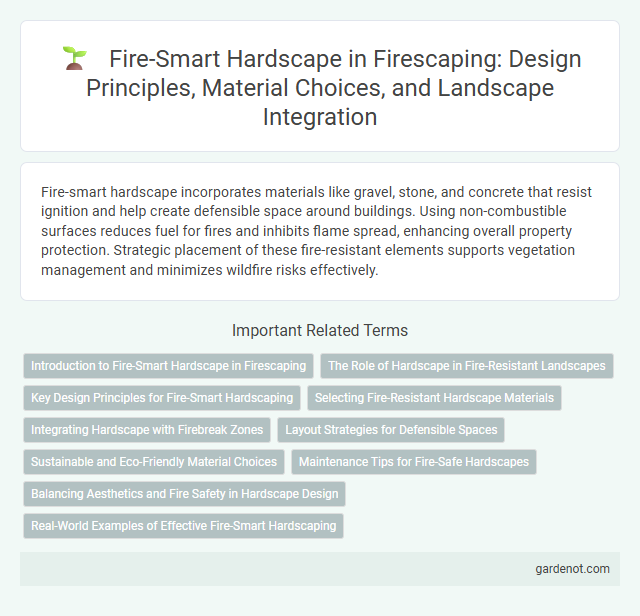Fire-smart hardscape incorporates materials like gravel, stone, and concrete that resist ignition and help create defensible space around buildings. Using non-combustible surfaces reduces fuel for fires and inhibits flame spread, enhancing overall property protection. Strategic placement of these fire-resistant elements supports vegetation management and minimizes wildfire risks effectively.
Introduction to Fire-Smart Hardscape in Firescaping
Fire-smart hardscape incorporates non-combustible materials such as stone, concrete, and brick to create defensible spaces that reduce wildfire risk around properties. These surfaces minimize fuel availability for fires, helping to prevent flames from spreading to vegetation or structures. Strategic placement of fire-resistant pathways, driveways, and patios enhances property safety and supports effective firefighting access during wildfires.
The Role of Hardscape in Fire-Resistant Landscapes
Hardscape elements such as gravel, stone pavers, and concrete surfaces act as effective firebreaks, reducing fuel continuity and slowing wildfire spread within fire-resistant landscapes. Incorporating fire-resistant materials in pathways, driveways, and retaining walls minimizes ignition sources and protects structures from radiant heat exposure. Strategic placement of hardscape features enhances defensible space, supporting plant selection and maintenance practices that collectively improve landscape resiliency to fire.
Key Design Principles for Fire-Smart Hardscaping
Fire-smart hardscaping design emphasizes the use of non-combustible materials such as stone, gravel, concrete, and brick to create defensible spaces that resist wildfire ignition. Key principles include maintaining clear zones free of vegetation near structures, incorporating fire-resistant barriers to interrupt fuel continuity, and ensuring proper spacing and layout for emergency access and evacuation routes. Strategic use of these elements enhances property protection while minimizing fire hazards in wildfire-prone areas.
Selecting Fire-Resistant Hardscape Materials
Selecting fire-resistant hardscape materials is essential for effective firescaping, reducing the risk of ignition and slowing fire spread around properties. Materials like concrete, brick, stone, and gravel offer non-combustible surfaces that withstand intense heat and prevent ember penetration. Integrating these fire-smart hardscape options enhances property protection while maintaining landscape aesthetics in fire-prone areas.
Integrating Hardscape with Firebreak Zones
Fire-smart hardscape integrates non-combustible materials such as concrete, stone, and gravel within firebreak zones to reduce wildfire risk and enhance landscape safety. Strategically placed patios, driveways, and retaining walls act as barriers that slow the spread of embers and flames, providing critical defensible space around structures. Incorporating fire-resistant hardscape elements complements vegetation management by creating distinct separations that minimize fuel continuity and improve overall fire resilience.
Layout Strategies for Defensible Spaces
Fire-smart hardscape layout strategies prioritize creating defensible spaces by incorporating non-combustible materials like stone, gravel, and concrete pathways that act as effective fire breaks. Designing clear zones with minimal flammable vegetation around structures reduces fire intensity and slows its spread, enhancing property protection. Integrating strategically placed patios, driveways, and retaining walls further fragments fuel continuity, improving overall fire resilience in landscape design.
Sustainable and Eco-Friendly Material Choices
Fire-smart hardscape integrates sustainable and eco-friendly material choices such as permeable pavers, natural stone, and recycled concrete, which reduce fire hazards while supporting environmental health. Using non-combustible materials with low thermal conductivity helps create effective defensible space around properties, minimizing fire spread risks. These choices promote durability and resource efficiency, aligning with eco-conscious landscaping practices that enhance fire resilience.
Maintenance Tips for Fire-Safe Hardscapes
Regularly removing dry leaves, pine needles, and other flammable debris from fire-smart hardscape surfaces reduces ignition risks around your property. Inspect and maintain non-combustible materials like stone, concrete, and gravel to ensure they remain intact and free from cracks where embers can lodge. Keep vegetation trimmed back at least 30 feet from hardscape edges to maintain defensible space and prevent fire spread.
Balancing Aesthetics and Fire Safety in Hardscape Design
Fire-smart hardscape design integrates fire-resistant materials like stone, concrete, and gravel to create attractive outdoor spaces that mitigate wildfire risks. Strategically placing non-combustible pavers and retaining walls can slow fire spread while enhancing landscape architecture. Balancing aesthetics and fire safety ensures functional beauty that protects property and lives in high-risk wildfire areas.
Real-World Examples of Effective Fire-Smart Hardscaping
Fire-smart hardscaping incorporates materials such as gravel, decomposed granite, and non-combustible pavers, effectively reducing wildfire fuel near structures. Notable examples include California homes using stone patios and concrete driveways paired with mineral mulch, which create defensible spaces that impede fire spread. These real-world installations demonstrate how strategic placement of fire-resistant hardscape elements can significantly enhance property safety in wildfire-prone areas.
Fire-smart hardscape Infographic

 gardenot.com
gardenot.com